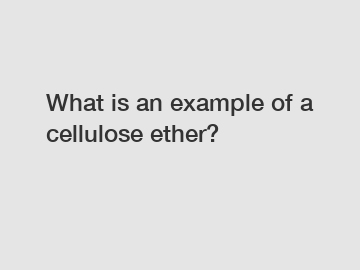Dec. 15, 2023
Chemicals
With competitive price and timely delivery, LONGOU sincerely hope to be your supplier and partner.
What is an example of a cellulose ether? .
Cellulose ethers are a group of chemical compounds derived from cellulose, a natural polymer found in plant cell walls. These compounds are widely used in various industries due to their unique properties and versatility. One such example of a cellulose ether is methyl cellulose (MC). Let's delve deeper into the characteristics, applications, and benefits of this particular cellulose ether.

1. Understanding cellulose ethers:
Cellulose ethers are created by chemically modifying cellulose molecules through processes such as etherification. These modifications involve replacing some of the hydroxyl groups in the cellulose structure with ether groups. This alteration enhances properties like solubility, water retention, and film-forming abilities, making cellulose ethers highly adaptable for numerous applications.
2. Methyl cellulose (MC):
Methyl cellulose is a cellulose ether derived from cellulose through the substitution of some hydroxyl groups with methyl groups. This structural modification results in a white, odorless, and tasteless powder that exhibits excellent water retention and film-forming properties. MC can dissolve in cold water, forming a clear, viscous solution. It finds extensive use in industries ranging from construction and pharmaceuticals to food and cosmetics.
3. Applications of MC:
a. Construction industry: MC is commonly used in construction materials, such as dry mix mortars, tile adhesives, and cement renders. Its water retention capabilities improve workability and prolong the curing process, ensuring better adhesion and reducing cracking in these applications.
b. Pharmaceutical industry: MC is widely utilized as an excipient in pharmaceutical formulations. It acts as a binder, thickener, and film-forming agent in tablet coatings, controlled-release systems, and topical formulations. MC enables precise drug release, improves stability, and enhances patient compliance.
Suggested reading:c. Food industry: MC finds applications as an emulsifier, stabilizer, and thickening agent in food products. Due to its non-toxic nature and lack of flavor, MC is commonly used in ice creams, bakery products, and sauces, providing texture, stabilizing foams, and improving overall quality.
d. Cosmetic industry: MC is extensively utilized in personal care and cosmetic products like creams, lotions, and shampoos. It acts as a thickener, emulsion stabilizer, and film-forming agent, imparting desirable texture and consistency to these products while enhancing their shelf life.
4. Benefits of using MC:
a. Water retention: MC has excellent water-holding capacity, which is crucial in various applications. It aids in preventing drying, ensuring better workability, and helping maintain hydration in products like mortar mixes and cosmetics.
b. Film-forming properties: MC can form a thin, transparent film that acts as a barrier. This property is highly beneficial in pharmaceutical coatings, food products, and cosmetics, providing protection, controlled release, and improved sensory characteristics.
c. Solubility: MC is soluble in both hot and cold water, offering versatility in its applications. Unlike many other cellulose ethers, which require heat for dissolution, MC can be easily incorporated into formulations without the need for high temperatures.
d. Non-toxic and biodegradable: As a cellulose derivative, MC is considered safe for consumption or contact with the skin. It is non-allergenic, biodegradable, and environmentally friendly, making it a preferred choice in industries where these qualities are essential.
In conclusion, methyl cellulose (MC) is a prime example of a cellulose ether with remarkable characteristics and wide-ranging applications. By modifying cellulose through etherification, MC exhibits enhanced water retention, film-forming properties, and solubility. It finds utility in construction, pharmaceuticals, food, and cosmetic industries, leveraging its benefits such as water retention, film formation, solubility, non-toxicity, and biodegradability. The versatility of cellulose ethers like MC continues to make significant contributions to various sectors, facilitating innovation and improving product performance.
If you are looking for more details, kindly visit Slip Resistance HEMC.
Suggested reading:Related Articles
If you are interested in sending in a Guest Blogger Submission,welcome to write for us!
All Comments ( 0 )